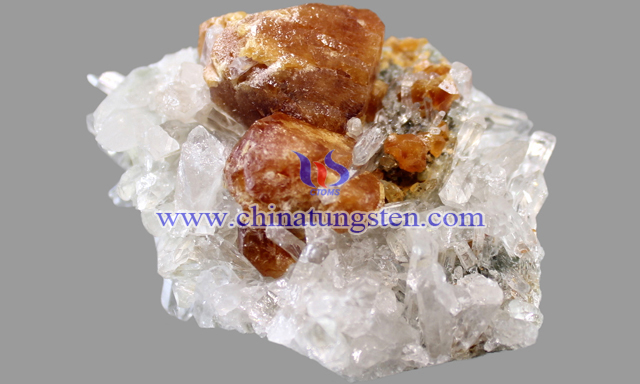Low-grade Tungsten Treatment Process and Equipment
- Details
- Category: Tungsten Information
- Published on Tuesday, 24 December 2019 17:27
The low-grade tungsten concentrate produced by some tungsten concentrators can not meet the quality standard, the grade of WO3 is 5-30%, and the content of other impurities is also relatively high. It is mainly low-grade tungsten slime concentrate, tungsten tin medium ore, tungsten bearing iron sand and other refractory tungsten containing intermediate products. These products are sold in the form of sodium tungstate or scheelite, ammonium paratungstate, tungstic acid or tungsten trioxide through chemical beneficiation, and other useful components are comprehensively recovered from the leaching slag. The principle process of chemical beneficiation of low-grade tungsten mineral raw materials can be divided into material preparation, etc.

In industrial production, soda sintering water leaching method, soda solution pressure boiling method, caustic soda solution leaching method and acid decomposition method are used. Its purpose is to decompose tungsten minerals into water-soluble tungstate. The choice of decomposition method mainly depends on the characteristics of tungsten mineral raw materials and the specific conditions and conditions of manufacturers. The treatment process can be divided into:
1. Soda sintering water immersion method. It is suitable for the treatment of low-grade wolframite raw materials with a small amount of quartz, such as tungsten slime, wolframite, tungstate tin ore, etc., and also for the treatment of low-grade scheelite raw materials with a small amount of quartz. During sintering, the water-soluble wolframite and scheelite react with soda to form water-soluble sodium tungstate. The water-soluble sintering agglomerates make the tungsten transfer into the solution, and the solid-liquid separation can remove the insoluble impurities. The sintering temperature of wolframite is 700-850 ℃, and that of scheelite is 860 ℃.
2. Caustic solution leaching. A 35-40% caustic soda solution was heated to 110-120 ℃ and the ground mineral materials were leached under pressure. The tungsten was transferred into the leach solution in the form of soluble sodium tungstate. There are two treatment methods for leaching and injection: one is to directly dilute it to a density of 1.3 g / cm3 and send it to purification; the other is to evaporate it to a density of about 1.45 g / cm3 and precipitate sodium tungstate crystal, the crystal solution returns to leaching operation, and the crystal aqueous solution is sent to purification. Compared with the soda sintering water leaching method, this method has the advantages of simple process, less investment and can deal with tungsten mineral raw materials such as tungsten slime with high silicon content and tungsten tin medium ore. The leaching reaction of Scheelite from caustic soda solution at atmospheric pressure is reversible. Generally, the mixed solution of caustic soda and sodium silicate should be used as leaching agent to obtain satisfactory leaching results.
3. Acid decomposition. The acid decomposition method can be used to treat scheelite and wolframite. 32-38% concentrated hydrochloric acid or nitric acid is used as leaching agent to decompose the tungsten minerals directly and form tungstic acid precipitate at a temperature of about 100 ℃. In order to improve the leaching rate of tungsten, it is necessary to grind the material to - 300 mesh. During acid decomposition, a considerable part of impurities enter the solution and are separated from tungstic acid by solid-liquid separation. In order to separate the tungstic acid from the residue, the alkali fusion method is often used to transfer the tungsten into the solution in the form of alkali metal tungstate, so as to obtain the purer solution of sodium tungstate or ammonium tungstate. The leaching rate of acid decomposed tungsten is high, but the reagent consumption is large.
4. Soda solution pressure boiling method. This method can be used to treat raw materials of scheelite and wolframite. The leaching process is carried out in a autoclave. The raw material is ground to - 300 mesh. The leaching rate of tungsten is related to the amount of soda, the pressure and the temperature of leaching.
The advantage of this method is that it has good applicability. It is not only suitable for the treatment of low-grade scheelite (5-15%), but also suitable for the treatment of tungsten bearing sulfide concentrate, such as tungsten bismuth intermediate ore and bismuth molybdenum tungsten intermediate ore. During the leaching of high sulfur tungsten, cassiterite, stibnite and bismuth remain in the residue. All copper, part silicon oxide, fluorine, phosphorus, arsenic and other impurities in the oxide are transferred into the leaching solution together with tungsten, and the leaching solution is sent for purification treatment.
- Tungsten Manufacturer & Supplier, Chinatungsten Online: www.chinatungsten.com
- Tungsten News & Prices of China Tungsten Industry Association: www.ctia.com.cn
- Molybdenum News & Price: news.molybdenum.com.cn
- Tel.: 86 592 5129696; Fax: 86 592 5129797; Email: sales@chinatungsten.com



 sales@chinatungsten.com
sales@chinatungsten.com